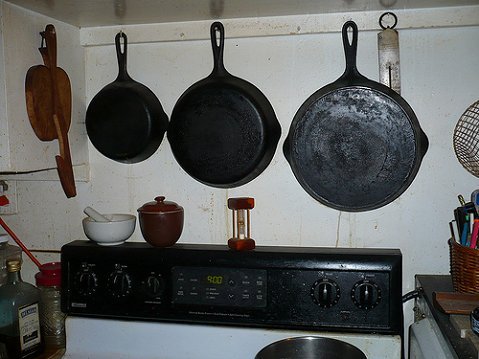Seasoning cast iron cookware. There’s more to it than you might think

Seasoning cast iron is not just something you must do to clean it. To begin with you should really know something about cast iron. What is it? Why is it such a great cooking utensil? Why does it put all of the others to shame?
Cast iron is used for making cookware because it has the ability to retain heat and to diffuse that heat that allows the utensil to evade the hot spots that occur in normal steel cookware.
In order for the cast iron surface to allow food to not stick to the surface it must be seasoned first.
For many hundreds of years bare cast iron has been used for cooking. It can withstand much higher temperatures than steel and is excellent for searing, frying and does a great job braising as well as stewing. After seasoning the pans properly they can develop an excellent non-stick surface making the challenge of producing egg dishes including scrambled eggs a breeze. Baking cornbread and upside-down cakes in cast iron ware is a joy.
Cast iron cookware comes in various items including tea pots, griddles, flattop grills, skillets, woks, dutch ovens, deep fryers.
As cast iron cookware is being used it leaches trace amounts of iron into the food. This phenomenon can be an advantage for those who are iron deficient or a disadvantage for those with excess iron issues.
Seasoning is the process used to seal the iron from rusting and to protect the pan surface with a non stick ability. This protects the food from interacting with the surface of the pan. The seasoning process causes a chemical reaction with the iron protecting the surface against corrosion. Seasoning may also occur naturally by simply using the cookware as the foods deposit the oils and fats on the iron.
When you purchase a new cast iron utensil it is not pre seasoned but is usually coated with a protective coating. This coating is on there to protect the pan from rusting while sitting on a shelf or in a warehouse for a long time and must be removed by scouring with a good scouring pad and washing thoroughly before seasoning.
- Cleaning the utensil.
- Applying the oil or fat.
- Heating the cookware.
If it is a new pan you wish to clean you must remove the protective coating. This coating may be shellac and in order to remove it you must scrub the surface completely. Make certain you get down into the corners deeply and do the sides and top edges as shellac can be very harmful to your body.
- Pre heat the oven to 300F and place a layer of aluminum foil on the bottom to protect it from drippings of fat.
- Assuming that you have thoroughly washed the pan as outlined above, you must dry it completely with the dish towel or place it in the oven to dry.
- Using a heavy fat like lard or Crisco and coat the pan and lid evenly inside and out.
- Place the pan and lid in your oven upside down and leave it in for about an hour. If you fail to place it upside down the fat or oil will accumulate in the bottom of the pan and that’s not what you want.
This process of Seasoning cast iron works best if you repeat the coating and heating steps a couple of times to insure an even coat.
Return from Seasoning Cast Iron to Whistler Outdoors



